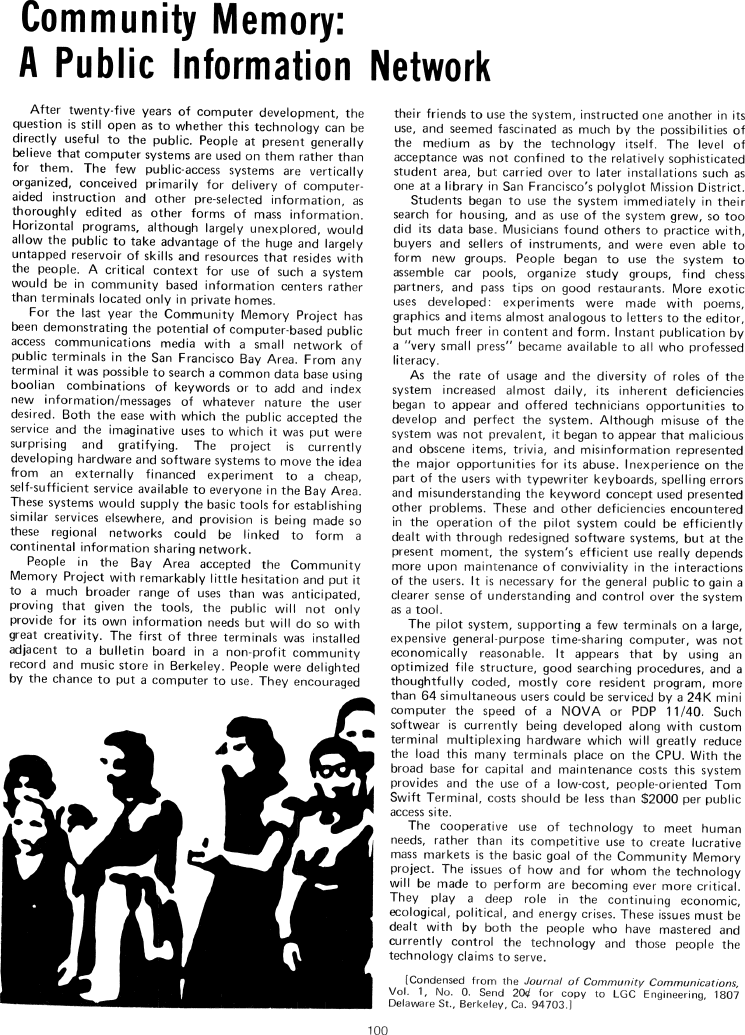The Best of Creative Computing Volume 1 (published 1976)
Community Memory: A Public Information Network (Community Memory Project, early public-access computer terminals)

Community Memory:
A Public information Network
After twenty-five years of computer development, the
question is still open as to whether this technology can be
directly useful to the public. People at present generally
believe that computer systems are used on them rather than
for them. The few public-access systems are vertically
organized, conceived primarily for delivery of computer-aided instruction and
other pre-selected information, as
thoroughly edited as other forms of mass information.
Horizontal programs, although largely unexplored, would
allow the public to take advantage of the huge and largely
untapped reservoir of skills and resources that resides with
the people. A critical context for use of such a system
would be in community based information centers rather
than terminals located only in private homes.
For the last year the Community Memory Project has
been demonstrating the potential of computer-based public
access communications media with a small network of
public terminals in the San Francisco Bay Area. From any
terminal it was possible to search a common data base using
boolian combinations of keywords or to add and index
new information/messages of whatever nature the user
desired. Both the ease with which the public accepted the
service and the imaginative uses to which it was put were
surprising and gratifying. The project is currently
developing hardware and software systems to move the idea
from an externally financed experiment to a cheap,
se|f-sufficient service available to everyone in the Bay Area.
These systems would supply the basic tools for establishing
similar services elsewhere, and provision is being made so
these regional networks could be linked to form a
continental information sharing network.
People in the Bay Area accepted the Community
Memory Project with remarkably little hesitation and put it
to a much broader range of uses than was anticipated,
proving that given the tools, the public will not only
provide for its own information needs but will do so with
great creativity. The first of three terminals was installed
adjacent to a bulletin board in a non-profit community
record and music store in Berkeley. People were delighted
by the chance to put a computer to use. They encouraged
[image]
their friends to use the system, instructed one another in its
use, and seemed fascinated as much by the possibilities of
the medium as by the technology itself. The level of
acceptance was not confined to the relatively sophisticated
student area, but carried over to later installations such as
one at a library in San Francisco's polyglot Mission District.
Students began to use the system immediately in their
search for housing, and as use of the system grew, so too
did its data base. Musicians found others to practice with,
buyers and sellers of instruments, and were even able to
form new groups. People began to use the system to
assemble car pools, organize study groups, find chess
partners, and pass tips on good restaurants. More exotic
uses developed: experiments were made with poems,
graphics and items almost analogous to letters to the editor,
but much freer in content and form. Instant publication by
a "very small press" became available to all who professed
literacy.
As the rate of usage and the diversity of roles of the
system increased almost daily, its inherent deficiencies
began to appear and offered technicians opportunities to
develop and perfect the system. Although misuse of the
system was not prevalent, it began to appear that malicious
and obscene items, trivia, and misinformation represented
the major opportunities for its abuse. lnexperience on the
part of the users with typewriter keyboards, spelling errors
and misunderstanding the keyword concept used presented
other problems. These and other deficiencies encountered
in the operation of the pilot system could be efficiently
dealt with through redesigned software systems, but at the
present moment, the system's efficient use really depends
more upon maintenance of conviviality in the interactions
of the users. It is necessary for the general public to gain a
clearer sense of understanding and control over the system
as a tool.
The pilot system, supporting a few terminals on a large,
expensive general-purpose time-sharing computer, was not
economically reasonable. It appears that by using an
optimized file structure, good searching procedures, and a
thoughtfully coded, mostly core resident program, more
than 64 simultaneous users could be serviced by a 24K mini
computer the speed of a NOVA or PDP 11/40. Such
softwear is currently being developed along with custom
terminal multiplexing hardware which will greatly reduce
the load this many terminals place on the CPU. With the
broad base for capital and maintenance costs this system
provides and the use of a low-cost, people-oriented Tom
Swift Terminal, costs should be less than $2000 per public
access site.
The cooperative use of technology to meet human
needs, rather than its competitive use to create lucrative
mass markets is the basic goal of the Community Memory
project. The issues of how and for whom the technology
will be made to perform are becoming ever more critical.
They play a deep role in the continuing economic,
ecological, political, and energy crises. These issues must be
dealt with by both the people who have mastered and
currently control the technology and those people the
technology claims to serve.
[Condensed from the Journal of Community Communications,
Vol. 1, No. 0. Send 20¢ for copy to LGC Engineering, 1807
Delaware St., Berkeley, Ca. 94703.]
100


